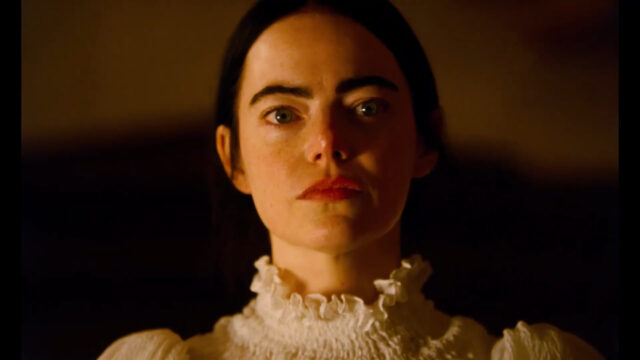
The post Poor Things: Life Among the Dead, by Scott Nye appeared first on Battleship Pretension.
Yorgos Lanthimos (The Lobster, The Favourite, Dogtooth) has never been one for subtlety, though at least he can look to novelist Alasdair Gray for giving him a character named God who creates new life in a young woman. Godwin Baxter (Willem Dafoe), more directly, is a sort of mad scientist, horribly disfigured and – aside from his lectures – a bit of a shut-in. The woman in his care he calls Bella (Emma Stone) is a tottering child-like mess who pees on the floor, uses only the simplest sentences when she has any at all, and cuddles, childlike, in his bed.
She is, of course, as one could only have guessed, the result of a pregnant woman’s suicide, whose body wound up in God’s possession, leaving him little alternative but to put the infant’s brain in the woman’s body, shock it back to life, and, well, see what happens. He relays this to his new apprentice, Max (Ramy Youssef), as naturally as you or I might describe calling AAA for a battery jump, but given his own unending horrific backstory as the test subject for a father who gradually discovered just which organs and body parts are strictly necessary for survival, “natural” has very different meanings for very different people.
Max is Bella’s first exposure to a wider world just as her brain is rapidly catching up with her body, and before long, she yearns for a world beyond God’s plushy-appointed-but-not-overly-ostentatious confines. Enter Duncan Wedderburn (Mark Ruffalo), an attorney God employs to see how legal he can make a marriage between Max and Bella while keeping the latter under his care. Duncan is a cad, to put it mildly. He can only see in the proposed contract the clear existence of a woman so extraordinary, he must have her for himself. Fortunately for him, he finds her as she’s discovering her own sexuality.
And so off they set. Lanthimos, working with his largest budget to date, realizes the world in vast extremities, with sets and photography out of a fever dream one might have after watching the collective works of Karel Zeman and Terry Gilliam. Each place is the essence and outlandish brink of itself, burning in yellows and pulsating with lives only slightly less demented than her own. Saying she’s awestruck by these places is too simplistic – increasingly, Bella is captivated more by the possibilities of the world than its present opportunities.
Since winning her Oscar for La La Land, Stone has stuck mostly to a series of safe choices, from the stock historical feature Battle of the Sexes to reprising prior roles in sequels Zombieland: Double Tap and The Croods: A New Age to a noble attempt to make intellectual property her own with Cruella. The big standout in that run was The Favourite, where she skilfully held her own against the more dynamic roles Olivia Colman and Rachel Wesiz seized so memorably.
Poor Things represents a new frontier for her, a film that lives or dies explicitly on her performance, and which she seizes every depraved, triumphant moment from. Bella is an iconic creation, her long ink-black hair and sharp eyebrows offsetting the growing sexual dominion no man can ignore. She plays Bella’s growing maturity, scene by scene, spectacularly, neither ensuring each scene shows just a bit of progress, so that her mental growth when the story requires it does not seem at all out of place. And she gets great lines like “I must go punch that baby” to relish.
The wider ensemble contributes plenty while keeping their contributions toward the favor of honoring her. Dafoe’s God is beholden to her for being like his child, and he looks at her with a tenderness that his scientific drive regrets so much developing. His own growing fatherly affection is the film’s most touching element, like watching Frankenstein play with the flowers. Ruffalo, though, would steal the show from Stone if his character wasn’t so hideously and hilariously devoted to her. Much of this film calls to mind Barbie, only its version of Ken is watching his independence vanish beneath his raw carnal lust. Ruffalo has not been called upon to channel this degree of vapid narcissism in awhile and I feel now poorer for those lost years.
Reteaming with cinematographer Robbie Ryan (The Favourite), alongside new collaborators Holly Weddington (Lady Macbeth) on costumes and James Price (The Nest) and Shona Heath on production design, Lanthimos and team create images that wear their influence well while becoming fully their own thing. Alongside Lanthimos’s longtime editor Yorgos Mavropsaridis, the early, black-and-white scenes set the viewer off edge the same way Bella would be, glimpsing pieces of her life without understanding how they fit together. As she gains coherence, so too does her world come into focus, culminating in more ordinary environs, with uncommon certainty of herself.
While The Favourite suggested a gear-shift for Lanthimos into something more mainstream, Poor Things affirms that he has lost none of his courage in the process, taking the moment of his greatest success and delivering his wildest film to date. Poor Things doesn’t cut as deep as those earlier films, but it isn’t interested in doing so. Strangely enough, it might be his first to suggest genuine hope for the future.
The post Poor Things: Life Among the Dead, by Scott Nye first appeared on Battleship Pretension.
The post Poor Things: Life Among the Dead, by Scott Nye appeared first on Battleship Pretension.


